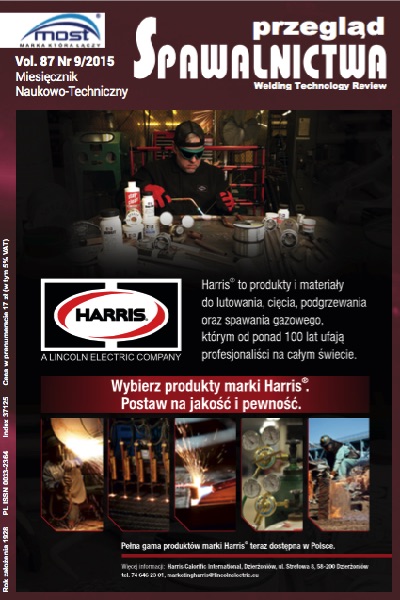Powłoki dla ochrony przed zużyciem elementów maszyn i urządzeń
Main Article Content
Abstract
Dokonano analizy przyczyn zużycia maszyn i urządzeń oraz przedstawiono możliwości ograniczania zużywania się elementów poprzez wytwarzanie na ich powierzchniach plazmowo natryskiwanych powłok z mieszanin najtwardszych materiałów z miękką fazą wiążącą, tworzącą metalurgiczne połączenie z podłożem. Przeprowadzono pomiary mikrotwardości oraz odporności na zużycie ścierne i erozyjne wytypowanych powłok ceramicznych i cermetalowych Uzyskane wyniki porównano z wynikami ścierania stalowych próbek - uzyskując dla powłok znaczący wzrost odporności. Wytypowanymi powłokami natryskano elementy maszyn i urządzeń, poddano je eksploatacji przemysłowej. Uzyskane wyniki uzasadniają celowość wytwarzania powłok na elementach maszyn i urządzeń.
Coatings for protection against wear of machinery
Abstract
The mechanism is described of corrosive processes occurring on the heated walls of boilers, both at low temperatures, i.e. in the furnace zone, and at medium temperatures, i.e. on the steam superheater surfaces. Further part of the work analyzes the processes of pitting corrosion occurring in the presence of the oxides of nitrogen, sulfur, and chlorine, which dissolve in water vapour condensing on the metal walls of heat equipment under the furnace lining. Moreover, the causes of the erosive wear of heat equipment walls are described. The examination were carried out of the properties of plasma sprayed ceramic and cermet coatings that are marked by the ability of forming a tight barrier impermeable to corrosive agents. The measurements were made, including porosity, erosive wear resistance, and the ability of reducing steel substrate corrosion. Based on the results obtained, the evaluation was performed of the usefulness of coatings for reducing the wear processes of heat equipment metal walls. Results from the industrial operation of elements with protective coatings are reported.
Downloads
Article Details
Creative Commons CC BY 4.0 https://creativecommons.org/licenses/by/4.0/
Welding Technology Review (WTR) articles are published open access under a CC BY licence (Creative Commons Attribution 4.0 International licence). The CC BY licence is the most open licence available and considered the industry 'gold standard' for open access; it is also preferred by many funders. This licence allows readers to copy and redistribute the material in any medium or format, and to alter, transform, or build upon the material, including for commercial use, providing the original author is credited.
References
St. Morel: Powłoki natryskiwanie cieplnie Monografia. Wyd. WIPMiFS Politechnika Częstochowska, Częstochowa 1990.
S. Morel: Application of Plasma-Sprayed Coatings in Heat Absorption by Radiated Walls. Archive of Energetics / Archiwum Energetyki T. 41 nr 3-4, 2011, s. 111-126.
A. Hernas, J. Dobrzański: Trwałość i niszczenie elementów kotłów i turbin parowych. Wyd. Politechniki Śląskiej 2003, str. 24-45.
T. Burakowski, T. Wierzchoń: Inżynieria powierzchni metali. Wyd. WNT Warszawa 1995.
B.G. Abrgmowicz, W.Ł. Goldsztein: Intienisifikacja tiepłobmiena izłuczeniem s pomoszczju pokrytej. Wyd. Eniergia, Moskwa 1977, str. 26-39.
T. Węgrzyn, J. Piwnik: Low alloy welding with mocro-jet cooling. Archives of Metllurgy and Materials, vol. 57, Iss. 2, 2012.
S. Morel: Zastosowanie powłok plazmowych w hutniczych urządzeniach grzewczych. Hutnik-Wiadomości Hutnicze R. 78, nr 5, 2011, s. 449-451.
S. Morel: Koszty wytwarzania powłok metodami natryskiwania cieplnego. Przegląd Spawalnictwa, R. 84, nr 8, 2012, s. 7-10.
S. Morel, J. Jasiński, L. Jeziorski: Powłoki natryskiwane plazmowo na elementach urządzeń do fluidalnej obróbki cieplnej. Inżynieria Materiałowa, R. 33, nr 5 (189), 2012, s. 456-459.
T. Hejwowski: Nowoczesne powłoki nakładane cieplnie odporne na zużycie ścierne i erozyjne. Wyd. Politechnika Lubelska 2013.
A.Hermas, B. Chmiela: Untypical bromine corrosion in bolers cofiring biomass. Journal of Achievements in Materials and Manufacturing Engineering 2012, vol. 54, nr 1, str. 58 66.
W. Bielikowski: Korozja powierzchni ogrzewalnych kotłów przy slaniu niskoemisyjnym. Energrtyka, nr 1, 2000, str. 45-51.
J.C. Nava: Cost-effective thermal spray coatings fort he boiler industry. Welding Journal, 2009, vol. 99, No 7.
M. Zubielewic Kierunki badań i rozwoju powłok ochronnych. Ochrona przed korozją, nr 4, 2006, str. 97-98.
http://www.worldsteel.org/media-centre/press-releases/2012/12- 2012-crude-steel.html; (14.02.2013).
Steel Heat Treatment Handbook. Metallurgy and Technologies, in: G.E. Totten, (Eds.), CRS Taylor & Francis Group, 2006.
M. Kaviany: Principles of Heat Transfer in Porous Media. 2nd edition, Springer, New York, 1995.
R. Singh: Thermal Conduction Through Porous System, in: A. Öchsner, et al. (Eds.), Cellular and Porous Materials: Thermal Properties Simulation and Prediction, WILEY-VCH Verlag GmbH & Co, KGaA, We- nheim, 2008, pp. 199-238.
J.H. Lienhard: A Heat Transfer Textbook. Third Edition. Phlogiston Press, Cambridge Massachusetts, 2010.
F.P. Incropera, D.P. DeWitt: Fundamentals of Heat and Mass Transfer, 6th edition, New York, Wiley 2007.
E. Kostowski: Heat flow. Silesian University of Technology Publishing House, Gliwice 2000.
M. Bahrami, M.M Yovanovich, J.R. Culham: Effective thermal conductivity of rough spherical packed beds, Int. J. Heat Mass Tran. 49 (2006), 3691-3701.
